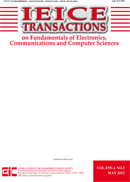E98.A 巻, 12 号
選択された号の論文の49件中1~49を表示しています
- |<
- <
- 1
- >
- >|
Special Section on Information Theory and Its Applications
-
2015 年E98.A 巻12 号 p. 2366
発行日: 2015/12/01
公開日: 2015/12/01
PDF形式でダウンロード (323K) -
原稿種別: PAPER
専門分野: Shannon Theory
2015 年E98.A 巻12 号 p. 2367-2375
発行日: 2015/12/01
公開日: 2015/12/01
PDF形式でダウンロード (709K) -
原稿種別: PAPER
専門分野: Shannon Theory
2015 年E98.A 巻12 号 p. 2376-2383
発行日: 2015/12/01
公開日: 2015/12/01
PDF形式でダウンロード (615K) -
The Error Exponent of Zero-Rate Multiterminal Hypothesis Testing for Sources with Common Information原稿種別: PAPER
専門分野: Shannon Theory
2015 年E98.A 巻12 号 p. 2384-2392
発行日: 2015/12/01
公開日: 2015/12/01
PDF形式でダウンロード (753K) -
原稿種別: PAPER
専門分野: Source Coding
2015 年E98.A 巻12 号 p. 2393-2406
発行日: 2015/12/01
公開日: 2015/12/01
PDF形式でダウンロード (404K) -
原稿種別: PAPER
専門分野: Source Coding
2015 年E98.A 巻12 号 p. 2407-2414
発行日: 2015/12/01
公開日: 2015/12/01
PDF形式でダウンロード (526K) -
原稿種別: PAPER
専門分野: Coding Theory
2015 年E98.A 巻12 号 p. 2415-2422
発行日: 2015/12/01
公開日: 2015/12/01
PDF形式でダウンロード (392K) -
原稿種別: PAPER
専門分野: Coding Theory
2015 年E98.A 巻12 号 p. 2423-2428
発行日: 2015/12/01
公開日: 2015/12/01
PDF形式でダウンロード (369K) -
原稿種別: PAPER
専門分野: Sequence
2015 年E98.A 巻12 号 p. 2429-2438
発行日: 2015/12/01
公開日: 2015/12/01
PDF形式でダウンロード (1633K) -
原稿種別: PAPER
専門分野: Sequence
2015 年E98.A 巻12 号 p. 2439-2445
発行日: 2015/12/01
公開日: 2015/12/01
PDF形式でダウンロード (552K) -
原稿種別: PAPER
専門分野: Cryptography and Information Security
2015 年E98.A 巻12 号 p. 2446-2455
発行日: 2015/12/01
公開日: 2015/12/01
PDF形式でダウンロード (1455K) -
原稿種別: PAPER
専門分野: Cryptography and Information Security
2015 年E98.A 巻12 号 p. 2456-2470
発行日: 2015/12/01
公開日: 2015/12/01
PDF形式でダウンロード (1616K) -
原稿種別: LETTER
専門分野: Shannon Theory
2015 年E98.A 巻12 号 p. 2471-2475
発行日: 2015/12/01
公開日: 2015/12/01
PDF形式でダウンロード (122K) -
原稿種別: LETTER
専門分野: Coding Theory
2015 年E98.A 巻12 号 p. 2476-2479
発行日: 2015/12/01
公開日: 2015/12/01
PDF形式でダウンロード (104K) -
原稿種別: LETTER
専門分野: Coding Theory
2015 年E98.A 巻12 号 p. 2480-2482
発行日: 2015/12/01
公開日: 2015/12/01
PDF形式でダウンロード (202K)
Special Section on VLSI Design and CAD Algorithms
-
2015 年E98.A 巻12 号 p. 2483
発行日: 2015/12/01
公開日: 2015/12/01
PDF形式でダウンロード (289K) -
原稿種別: PAPER
専門分野: High-Level Synthesis and System-Level Design
2015 年E98.A 巻12 号 p. 2484-2493
発行日: 2015/12/01
公開日: 2015/12/01
PDF形式でダウンロード (1644K) -
原稿種別: PAPER
専門分野: High-Level Synthesis and System-Level Design
2015 年E98.A 巻12 号 p. 2494-2504
発行日: 2015/12/01
公開日: 2015/12/01
PDF形式でダウンロード (1592K) -
原稿種別: PAPER
専門分野: High-Level Synthesis and System-Level Design
2015 年E98.A 巻12 号 p. 2505-2518
発行日: 2015/12/01
公開日: 2015/12/01
PDF形式でダウンロード (4309K) -
原稿種別: PAPER
専門分野: High-Level Synthesis and System-Level Design
2015 年E98.A 巻12 号 p. 2519-2527
発行日: 2015/12/01
公開日: 2015/12/01
PDF形式でダウンロード (2256K) -
原稿種別: PAPER
専門分野: High-Level Synthesis and System-Level Design
2015 年E98.A 巻12 号 p. 2528-2536
発行日: 2015/12/01
公開日: 2015/12/01
PDF形式でダウンロード (2153K) -
原稿種別: PAPER
専門分野: Logic Synthesis, Test and Verification
2015 年E98.A 巻12 号 p. 2537-2546
発行日: 2015/12/01
公開日: 2015/12/01
PDF形式でダウンロード (2364K) -
原稿種別: PAPER
専門分野: Logic Synthesis, Test and Verification
2015 年E98.A 巻12 号 p. 2547-2555
発行日: 2015/12/01
公開日: 2015/12/01
PDF形式でダウンロード (3258K) -
原稿種別: PAPER
専門分野: Logic Synthesis, Test and Verification
2015 年E98.A 巻12 号 p. 2556-2564
発行日: 2015/12/01
公開日: 2015/12/01
PDF形式でダウンロード (1113K) -
原稿種別: PAPER
専門分野: Physical Level Design
2015 年E98.A 巻12 号 p. 2565-2571
発行日: 2015/12/01
公開日: 2015/12/01
PDF形式でダウンロード (932K) -
原稿種別: PAPER
専門分野: Physical Level Design
2015 年E98.A 巻12 号 p. 2572-2583
発行日: 2015/12/01
公開日: 2015/12/01
PDF形式でダウンロード (1560K) -
原稿種別: PAPER
専門分野: Physical Level Design
2015 年E98.A 巻12 号 p. 2584-2591
発行日: 2015/12/01
公開日: 2015/12/01
PDF形式でダウンロード (6600K) -
原稿種別: PAPER
専門分野: Circuit Design
2015 年E98.A 巻12 号 p. 2592-2599
発行日: 2015/12/01
公開日: 2015/12/01
PDF形式でダウンロード (2859K) -
原稿種別: PAPER
専門分野: Circuit Design
2015 年E98.A 巻12 号 p. 2600-2606
発行日: 2015/12/01
公開日: 2015/12/01
PDF形式でダウンロード (3986K) -
原稿種別: PAPER
専門分野: Device and Circuit Modeling and Analysis
2015 年E98.A 巻12 号 p. 2607-2613
発行日: 2015/12/01
公開日: 2015/12/01
PDF形式でダウンロード (1330K) -
原稿種別: PAPER
専門分野: Device and Circuit Modeling and Analysis
2015 年E98.A 巻12 号 p. 2614-2624
発行日: 2015/12/01
公開日: 2015/12/01
PDF形式でダウンロード (2627K)
Regular Section
-
原稿種別: PAPER
専門分野: Digital Signal Processing
2015 年E98.A 巻12 号 p. 2625-2632
発行日: 2015/12/01
公開日: 2015/12/01
PDF形式でダウンロード (1783K) -
原稿種別: PAPER
専門分野: Digital Signal Processing
2015 年E98.A 巻12 号 p. 2633-2641
発行日: 2015/12/01
公開日: 2015/12/01
PDF形式でダウンロード (1182K) -
原稿種別: PAPER
専門分野: Digital Signal Processing
2015 年E98.A 巻12 号 p. 2642-2649
発行日: 2015/12/01
公開日: 2015/12/01
PDF形式でダウンロード (3546K) -
原稿種別: PAPER
専門分野: Digital Signal Processing
2015 年E98.A 巻12 号 p. 2650-2657
発行日: 2015/12/01
公開日: 2015/12/01
PDF形式でダウンロード (4601K) -
原稿種別: PAPER
専門分野: VLSI Design Technology and CAD
2015 年E98.A 巻12 号 p. 2658-2669
発行日: 2015/12/01
公開日: 2015/12/01
PDF形式でダウンロード (2441K) -
原稿種別: PAPER
専門分野: Graphs and Networks
2015 年E98.A 巻12 号 p. 2670-2676
発行日: 2015/12/01
公開日: 2015/12/01
PDF形式でダウンロード (848K) -
原稿種別: PAPER
専門分野: Cryptography and Information Security
2015 年E98.A 巻12 号 p. 2677-2685
発行日: 2015/12/01
公開日: 2015/12/01
PDF形式でダウンロード (938K) -
原稿種別: PAPER
専門分野: Intelligent Transport System
2015 年E98.A 巻12 号 p. 2686-2693
発行日: 2015/12/01
公開日: 2015/12/01
PDF形式でダウンロード (1841K) -
原稿種別: PAPER
専門分野: Image
2015 年E98.A 巻12 号 p. 2694-2700
発行日: 2015/12/01
公開日: 2015/12/01
PDF形式でダウンロード (1834K) -
原稿種別: LETTER
専門分野: Speech and Hearing
2015 年E98.A 巻12 号 p. 2701-2704
発行日: 2015/12/01
公開日: 2015/12/01
PDF形式でダウンロード (448K) -
原稿種別: LETTER
専門分野: Digital Signal Processing
2015 年E98.A 巻12 号 p. 2705-2708
発行日: 2015/12/01
公開日: 2015/12/01
PDF形式でダウンロード (255K) -
原稿種別: LETTER
専門分野: Digital Signal Processing
2015 年E98.A 巻12 号 p. 2709-2712
発行日: 2015/12/01
公開日: 2015/12/01
PDF形式でダウンロード (250K) -
原稿種別: LETTER
専門分野: Systems and Control
2015 年E98.A 巻12 号 p. 2713-2718
発行日: 2015/12/01
公開日: 2015/12/01
PDF形式でダウンロード (675K) -
原稿種別: LETTER
専門分野: Nonlinear Problems
2015 年E98.A 巻12 号 p. 2719-2722
発行日: 2015/12/01
公開日: 2015/12/01
PDF形式でダウンロード (593K) -
原稿種別: LETTER
専門分野: Numerical Analysis and Optimization
2015 年E98.A 巻12 号 p. 2723-2727
発行日: 2015/12/01
公開日: 2015/12/01
PDF形式でダウンロード (827K) -
原稿種別: LETTER
専門分野: Coding Theory
2015 年E98.A 巻12 号 p. 2728-2732
発行日: 2015/12/01
公開日: 2015/12/01
PDF形式でダウンロード (175K) -
原稿種別: LETTER
専門分野: Communication Theory and Signals
2015 年E98.A 巻12 号 p. 2733-2737
発行日: 2015/12/01
公開日: 2015/12/01
PDF形式でダウンロード (526K) -
原稿種別: LETTER
専門分野: Mobile Information Network and Personal Communications
2015 年E98.A 巻12 号 p. 2738-2742
発行日: 2015/12/01
公開日: 2015/12/01
PDF形式でダウンロード (360K)
- |<
- <
- 1
- >
- >|
